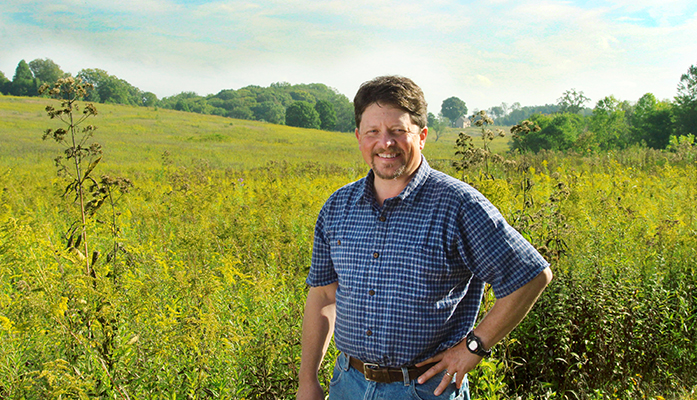
A Philadelphia native returns home to change the way the region thinks about horticulture
For Tom Brightman (Master of Environmental Studies ‘00), biodiversity is the first step in fostering a resilient and sustainable natural world. As the Land Stewardship Manager at Longwood Gardens, Tom is in charge of 700 acres of forest, wetlands, streams, meadows and agricultural lands. A major component of his job is to educate visitors and students about their relationship to their local landscape, “One of the largest issues is this ongoing need for helping others to understand what ecology is and how they are impacted by a healthy environment.”
Tom first discovered the fragile nature of ecosystems while working as a fly fishing guide in Colorado, “To be a good fly fisherman, you have to understand stream ecology—the intricacies of the aquatic insects, the habitat they need and how trout use the habitat and feed on the insects.” He joined the Colorado Division of Wildlife on a study about a nearby zinc mine’s impact on the local trout population. It was there he found his calling in regional ecology. Soon after, he enrolled in Penn’s Master of Environmental Studies program.
Born in Merion Station, PA, and the son of two Penn professors, Tom’s immersion in the local landscape through field-based courses connected the dots between his personal roots and his professional interests.
“There’s an aspect you can’t learn either in a classroom or online that you learn out in the landscape. One of the most valuable courses I had was the one Dr. Sally Willig teaches on Regional Field Ecology, and I also took her Wetlands class. Both of those were very specific to my target field of endeavor, and I felt that they really increased my plant knowledge exponentially. Another one was Conservation Biology, which at the time, was taught by Dr. John Smith. That really opened my eyes to global conservation issues.”
The multidisciplinary approach and flexibility of Penn’s Master of Environmental Studies program also allow students to expand their skill set beyond the University. While studying at Penn, Tom had the opportunity to volunteer with Bombay Hook National Wildlife Refuge where he became involved with a project on tracking the migratory habits of snow geese. For his capstone, Tom proposed a wetland revitalization project for Tyler Arboretum. His ever-growing field of expertise combined with his undergraduate background in legal studies and geography (BA American Civilization, Penn ‘85) made Tom a well-rounded candidate for the job market.
“The Penn MES helped me get my first position after graduation at the Brandywine Conservancy because their main issue was focusing on water resource protection and land conservation and how those two are integrated. It directly made getting that job very possible.”
When Tom landed at Longwood Gardens, the position brought together everything he was passionate about—resourceful uses of land, water ecology and helping the public interact with land in a meaningful way. In his nine years at Longwood, he has helped spearhead two capital projects—the Route 52 highway ecological restoration and the recent Meadow Garden Expansion project. The 86-acre Meadow Garden is a prime example of a landscape that is as beautiful as it is diverse and resilient. Tom notes proudly, “It’s a great place to be able to walk through and see how both horticulture and ecology blend together.”
The various meadows at Longwood not only provide healthy and abundant resources for local plant life and wildlife, it’s changing the way Longwood consumes energy. One meadow is home to a 1.53-megawatt solar structure, which would typically be laid on top of gravel. The meadow helps to minimize stormwater runoff and maximize biodiversity. By integrating a meadow into the solar complex, Longwood was able to invest in sustainable energy without losing any land and its benefits to the local ecosystem.
But it’s not enough for Tom to get his hands dirty in the fields to address these important issues. He also educates the public about everyday effects they have on the land underneath their feet, “Having an avenue for coursework and public landscapes where our guests can visit to see these kinds of things in action goes a long way to helping people understand it better…If landscapes like ours become too isolated or fragmented as a habitat, then they start to lose their ecological benefit. If others start to adopt similar land management across a region, it will leave more room for flow of genetic diversity.”
Through his work at Longwood, giving public addresses and teaching Penn’s Master of Environmental Studies Land Conservation and Management course, Tom hopes those he educates will take action to make our environment more adaptable for everyone, “When it comes to caring for your home or community land, think about what benefits could be implemented for our local fauna and plant communities...It’s very important that our home ecologies become a part of our regional ecologies, not apart from it.”
If you ever get the chance to speak with Tom Brightman, you will take in just how deeply he cares about his work. He may be an avid downhill skier and a sometimes trumpet player in a rock band, but helping build a more sustainable natural world is truly where his heart lies.
Tom’s degree proved to be transformative, “I’m so glad I took on the Penn MES and was able to move into this field of endeavor,” he beams, “My work is as much of my passion as it is my work, and I’ve never really felt that before. It makes coming to work every day very easy.”





